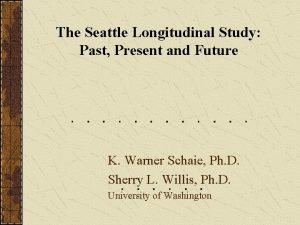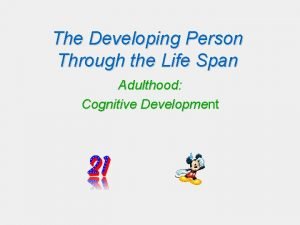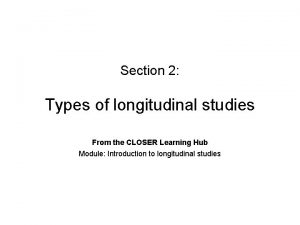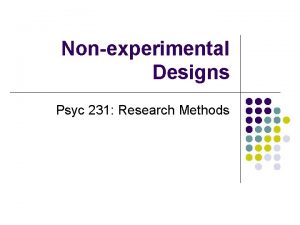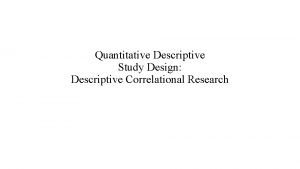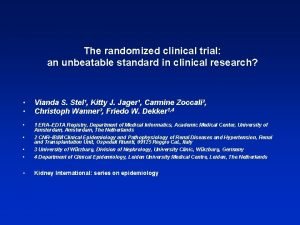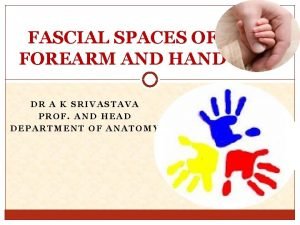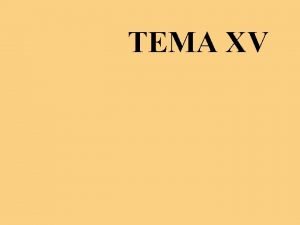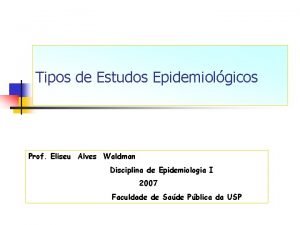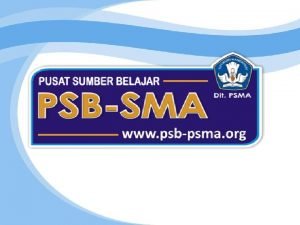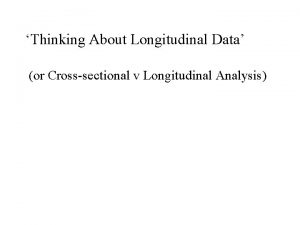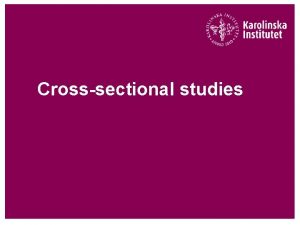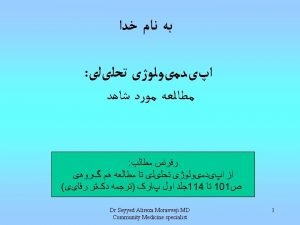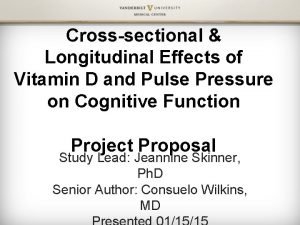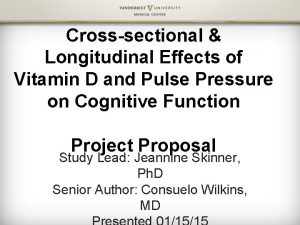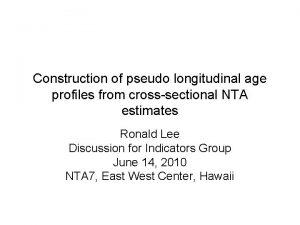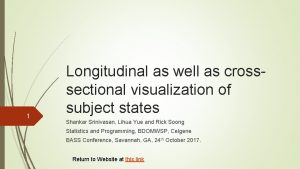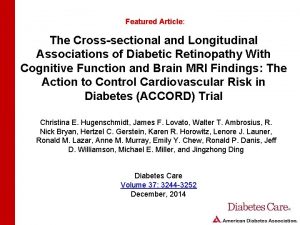1 n Descriptive Study Crosssectional study Longitudinal study





















- Slides: 21







������ (1) n Descriptive Study : ���������� �Cross-sectional study �Longitudinal study �Historical study ����

������ (2) n HISTORICAL STUDY �Historical and Report Review �Medical Record Review n CROSS-SECTIONAL STUDY �Prevalence Survey �School Health Survey �Community Health Survey






Characteristics of 526 TB index cases (1( %% HIV +ve (n 1=221) Age (years( n Mean + SD 33. 7+7. 2 n Median 33 Sex n Male 57. 9 n Female 42. 1 Ethnicity n Thai 93. 2 n Hill-tribe/other 6. 8 HIV -ve (n 2=305) p-value 50. 1+17. 2 49 <0. 001 68. 2 31. . 8 0. 015 81. 6 18. 4 <0. 001 Come back from another province to home in CR after get TB illness n n No Yes 71. 9 28. 1 95. 4 4. 6 <0. 001

Univariate analysis of predicting new TB among household contacts by characteristic of index cases (3( Prevalence of new TB (%) Crowding (persons/bedroom( n OR (95%CI( (2. 4) 19/785 2 > (1. 33 -5. 08) 2. 60 (6. 1) 28/4632 < Relationship to index cases n Other 6/320 (1. 9) n Spouse 11/279 (3. 9) n Son/daughter 19/333 (5. 7) n Sibling 3/100 (3. 0) n Parent 8/216 (3. 7) )Pearson chi-squared = 6. 8949 Pr = 0. 229( Ref. n Ref. 2. 15 (0. 82 -5. 60( 3. 17 (1. 19 -8. 42( 1. 62 (0. 40 -6. 59( 2. 01 (0. 69 -5. 86(

Univariate analysis of predicting new TB among household contacts by characteristic of contacts (1( Prevalence of new TB (%) OR (95%CI( Age group (years) : Pearson chi 2(7) = 12. 4579 Pr = 0. 086( n 0 -4 8/114 (7. 0) Ref. n 5 -14 12/244 (4. 9) 0. 69 (0. 28 -1. 70( n 15 -24 2/152 (1. 3) 0. 18 (0. 04 -0. 86( n 25 -34 8/167 (4. 8) 0. 67 (0. 24 -1. 86( n 35 -44 2/171 (1. 2) 0. 16 (0. 04 -0. 65( n 45 -54 3/142 (2. 1) 0. 29 (0. 07 -1. 12( n 55 -64 7/129 (5. 4) 0. 86 (0. 26 -2. 22( n (0. 17 -1. 70) 0. 53 (3. 9) 5/12965 < Sex n Female 27/702 (3. 9) Ref. n Male 20/546 (3. 7) 0. 95 (0. 50 -1. 08(

DNA fingerprinting of TB confirmation

Thank you for your attention

�������� Tuberculin skin test survey in a pediatric population with high BCG vaccination coverage -- Botswana, 1996 n n Tuberculosis (TB) causes more deaths worldwide than any other infectious disease: in 1995, TB caused an estimated 3 million deaths, of which 170, 000 (6%) occurred among children aged <15 years Diagnosing TB in children often is difficult and relies on clinical judgement and use of algorithms that include chest radiography and the tuberculin skin test (TST). However, interpretation of TST reactivity can be complicated by many factors other than infection with Mycobacterium tuberculosis. Ref. : Morb. Mortal. Wkly Rep. 1997 Vol. 46; 846 -851.

�������� Tuberculin skin test survey in a pediatric population with high BCG vaccination coverage -- Botswana, 1996 n n For example, previous BCG vaccination or exposure to NTB can result in positive TST reactions indistinguishable from those caused by M. tuberculosis. In contrast, such factors as HIV infection, poor nutritional status, and recent viral or bacterial infections or vaccination with live virus can reduce response to the TST. Ref. Simson et al [370]

Objective & results n n To assess the use of the TST for diagnosing pediatric TB in a population with high BCG coverage, a TST survey was conducted during July -August 1996 among children aged 3 -60 months in Botswana (1991 population: 1. 3 million). The findings indicate that most positive TSTs (induration > or =10 mm) among children in Botswana can be attributed to TB infection rather than previous BCG vaccination and that the TST remains useful for diagnosing pediatric TB in Botswana Ref. Simson et al [370]
 What is longitudinal study in psychology
What is longitudinal study in psychology What is the seattle longitudinal study
What is the seattle longitudinal study Sequential vs longitudinal study
Sequential vs longitudinal study Longitudinal design
Longitudinal design Longitudinal design psychology
Longitudinal design psychology Stability vs change ap psychology
Stability vs change ap psychology Sequential vs longitudinal study
Sequential vs longitudinal study Difference between case control and cohort study
Difference between case control and cohort study Longitudinal study qualitative or quantitative
Longitudinal study qualitative or quantitative Correlational descriptive design
Correlational descriptive design Descriptive survey example
Descriptive survey example What is descriptive study in epidemiology
What is descriptive study in epidemiology Cross sectional study
Cross sectional study Klumpke paralizisi
Klumpke paralizisi Forearm space of parona diagram
Forearm space of parona diagram Análise espectral
Análise espectral Espuridad
Espuridad Papillary muscle
Papillary muscle Estudo longitudinal
Estudo longitudinal Longitudinal research design example
Longitudinal research design example Ciri ciri gelombang bunyi
Ciri ciri gelombang bunyi Longitudinal construction joint
Longitudinal construction joint

